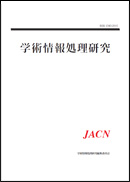Volume 8, Issue 1
Displaying 1-6 of 6 articles from this issue
- |<
- <
- 1
- >
- >|
Original paper
-
Article type: research-article
2004Volume 8Issue 1 Pages 5-8
Published: September 17, 2004
Released on J-STAGE: August 08, 2019
Download PDF (135K) -
Article type: research-article
2004Volume 8Issue 1 Pages 9-16
Published: September 17, 2004
Released on J-STAGE: August 08, 2019
Download PDF (603K) -
Article type: research-article
2004Volume 8Issue 1 Pages 17-24
Published: September 17, 2004
Released on J-STAGE: August 08, 2019
Download PDF (377K) -
Article type: research-article
2004Volume 8Issue 1 Pages 25-32
Published: September 17, 2004
Released on J-STAGE: August 08, 2019
Download PDF (480K) -
Article type: research-article
2004Volume 8Issue 1 Pages 33-43
Published: September 17, 2004
Released on J-STAGE: August 08, 2019
Download PDF (1168K) -
Article type: research-article
2004Volume 8Issue 1 Pages 45-53
Published: September 17, 2004
Released on J-STAGE: August 08, 2019
Download PDF (1230K)
- |<
- <
- 1
- >
- >|
